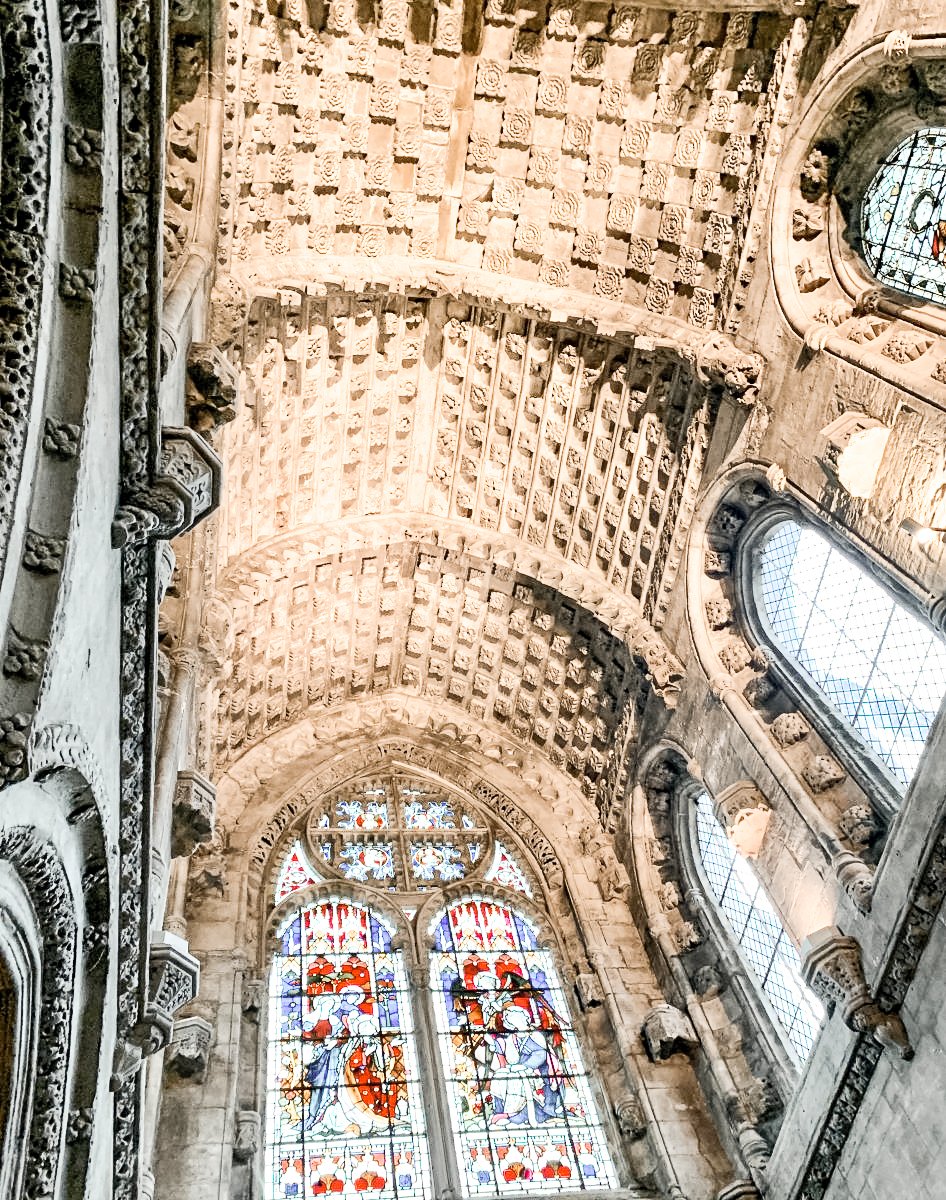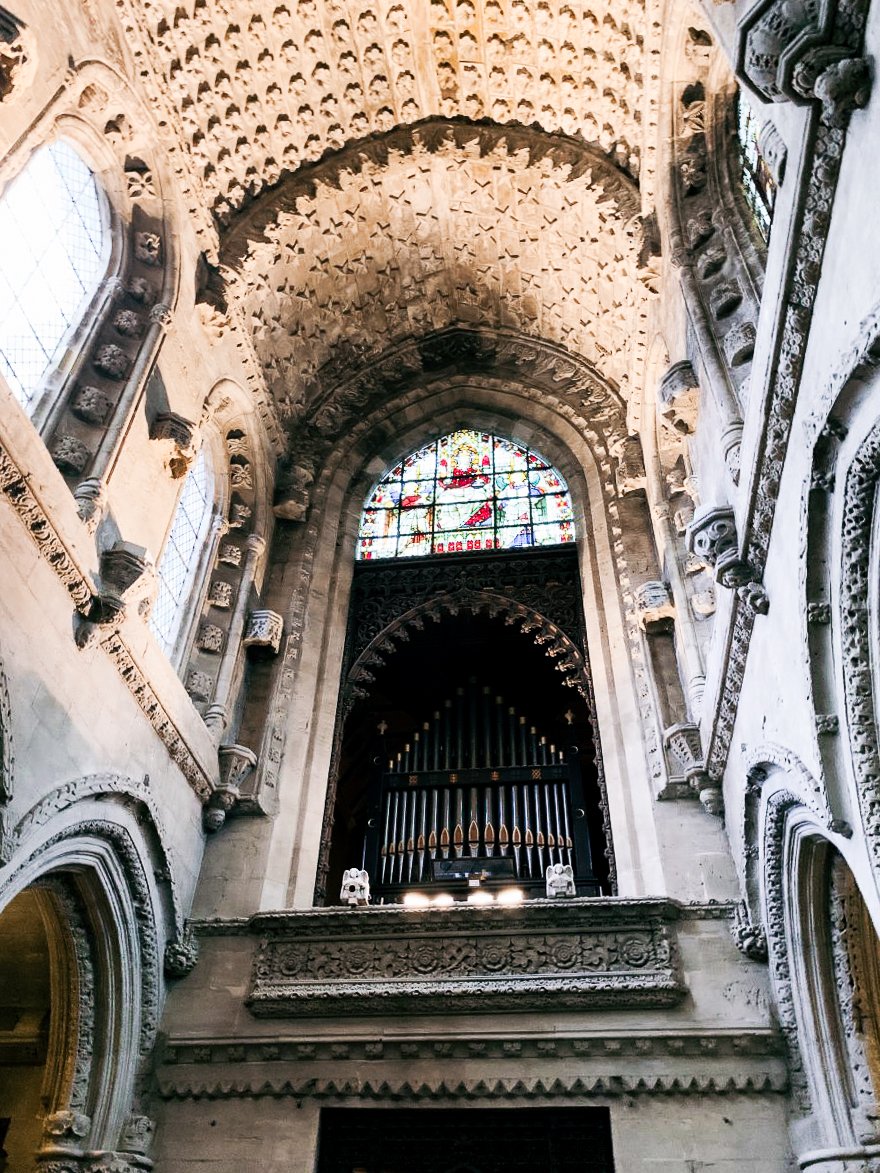Rosslyn chapel
Article originally published 6 May, 2019
FOR WHATEVER REASON, I’d never made it over the border. During the number of visits I’ve made to the UK, there had been an equal number of cancelled hotel rooms in Edinburgh. Plans changed, there was never enough time, and Scotland had remained elusive—that mysterious, haunting place to the North.
For me, an Australian lass of Anglo stock, Scotland has always been mixed up in the myth of beginnings, of ancestral roots and belonging— almost as much as England. So my visit to Scotland is a pilgrimage of sorts—of embracing icy winds, the thick warmth of tartan and and warming my rear beside an open fire beneath a mammoth stag’s head.
And Scotland doesn’t disappoint, neither with its misty wintery weather, nor with the romantic scale of its landscape and rugged history.
Sophie and I trek overland and cross the border into Scotland—to coin TS Elliott’s famous phrase, ‘not with a bang but a whimper’—we’re not on the A1 but a smaller country lane, but there’s still a sign:
Our first stop is the Rosslyn Chapel, still privately owned by Peter St.Clair-Erskine, the 7th Earl of Rosslyn. Aside from the history books, Rosslyn has been made even more famous by Dan Brown’s juggernaut novel, The Da Vinci Code and later by the (2006) movie adaptation of the same, which sees Tom Hanks and Audrey Tatou in the Chapel as the film draws to its conclusion.
Medieval historians refute the Chapel’s associations with the Knights Templar, The Holy Grail and the Freemasons of Brown’s book—going so far as to say the notion is poppycock. According to Mark Oxbrow and Ian Robertson in their book, Rosslyn and the Grail: “Rosslyn Chapel bears no more resemblance to Solomon’s or Herod’s Temple than a house brick does to a paperback book.”
But there’s no denying there is something mystical and mesmerising about the stone carvings inside the chapel. They not only took around 40 years to complete, but are laden with the symbolism Brown weaves into, and is at the core of, his novel’s plot.
Originally a Catholic Church founded by the William Sinclair, Ist Earl of Caithness in the mid fifteenth century, the chapel is located in Roslin, Midlothian. The lead-up to the chapel is not particularly exciting; a scattered jumble of houses, shopping strips and a reminder that modern life often encroaches on these great monuments. But immediately preceding it, Roslin itself is a charming village. There’s an added bonus for me here. Sophie’s ancestor, John Lawson-Johnston, invented Bovril—a thick and salty meat extract a bit like a Scottish Vegemite—was born in Roslin and a plaque celebrates his birthplace. So we stop for a quick picture.
After the Scottish Reformation in 1560, Rosslyn closed for public worship and it was not until 1861, that it reopened under the mantle of the Scottish Episcopal Church (linked to the Anglican Church).
Originally intended to be a cruciform design, this was never completed. It has been suggested that after the Ist Earl’s death, the building of the nave and transepts was aborted as there was either a lack of funds, interest or a change in liturgical direction and design.
Looking at the aerial photo, Rosslyn does appear to me as though it should have arms and legs—and its grander intentions have been stunted.
At close range, the carvings inside are bewitching and of the 110 green men, coming face to face with one of the human faces entwined with plant life coming out of their mouths is a bit like Freaky Friday. It beckons the question: why did Medieval Christians want to scare the daylight out of poor little worshippers? Power, is my guess.
But not all the carvings are terrifying. And while the green men are supposed to represent nature’s growth and fertility, there are far less confronting tributes to natural abundance at every turn, including carvings of strawberries, aloe vera, wheat and lilies.
I am also transfixed by the carving on a pillar of and angry devil and two lovers. Human passion always seems at odds with Christian chastity and purity—the pleasures of the flesh always seen as a sin. I continue to find this perplexing given love and sex are integral to our existence and the meaning in our lives. Human history, depicted through art, proves this battle has never really been any different for the greater populace. We have never been considered holy from the waist down. But love, devotion and family could never be more divine in my book.
I’m afraid my photos of the interior are extremely limited. In fact, reduced to two or three, before I realise photos are not allowed. I somehow missed that, such is my awe of the space. But I am summarily scolded by a busty Scottish school Ma’am masquerading as a tourist guide, with a formidable plastic lanyon swinging between her breasts concealed beneath a sensible polar fleece:
Poot that phone awae!
Damn.
This is followed by the complete humiliation (as her voices rings out in cavernous space, despite the crowds):
I said…poot that phone awae Madam! Nae photos are allowed in the chapel. Do I make m’self CLE-ARRR?
I shuffle my iPhone reluctantly back into my pocket. There are a few sniggers by surrounding tourists, a couple of sympathetic glances and a handsome young American still snapping a few feet away from me, clearly a recalcitrant in our midst – or maybe he’s just oblivious. I know he’s a Dan Brown devotee just by looking at him. But before I was ticked off, I managed these below, which if you look closely, show some of the detail of the vaulted roof, carved with carpets of floral motifs and stars. Quite beautiful and extraordinary.
Outside, the pure magic of the architecture comes to the fore. The iconic The flying buttresses (the curved arcs on the exterior that carry the weight of the roof) are something to behold given the time of their construction. I think back to reading Ken Follett’s The Pillars of the Earth and although the fictitious cathedral in Follet’s book was earlier still—from memory–the ground breaking ability of both architect and master craftsmen in building these marvels must be acknowledged.
Rosslyn Chapel, is not as big as I imagined it would be, and indeed there are far grander churches and cathedrals. But it is, I remind myself, a chapel and it is meant to be more intimate. Rosslyn is also far more exquisite, intricate and magical than I expected. Its ethereal qualities make the building come alive—and it feels much more than just carved stone. It seems to breathe. The building is so multi-faceted, it’s difficult to know where to rest my eyes.
We step into the drizzle and I feel I’ve only just scratched the surface. But it’s difficult in these places to find the space to think, to absorb. There are always so many people wanting a piece of it—just like we do.
I’m relieved, however, as we wander back through the shop to the exit, there are two bus loads of tourists arriving and I’m glad we’ve escaped the crush.
It’s cold. Actually, Scotland is freezing. Is it really spring here? North Yorkshire seems balmy in comparison. We rub our hands together, slide into the heated leather seats of the car and flick on a Spotify play list.
Next stop? Sophie and I grin at each other. Edinburgh.






